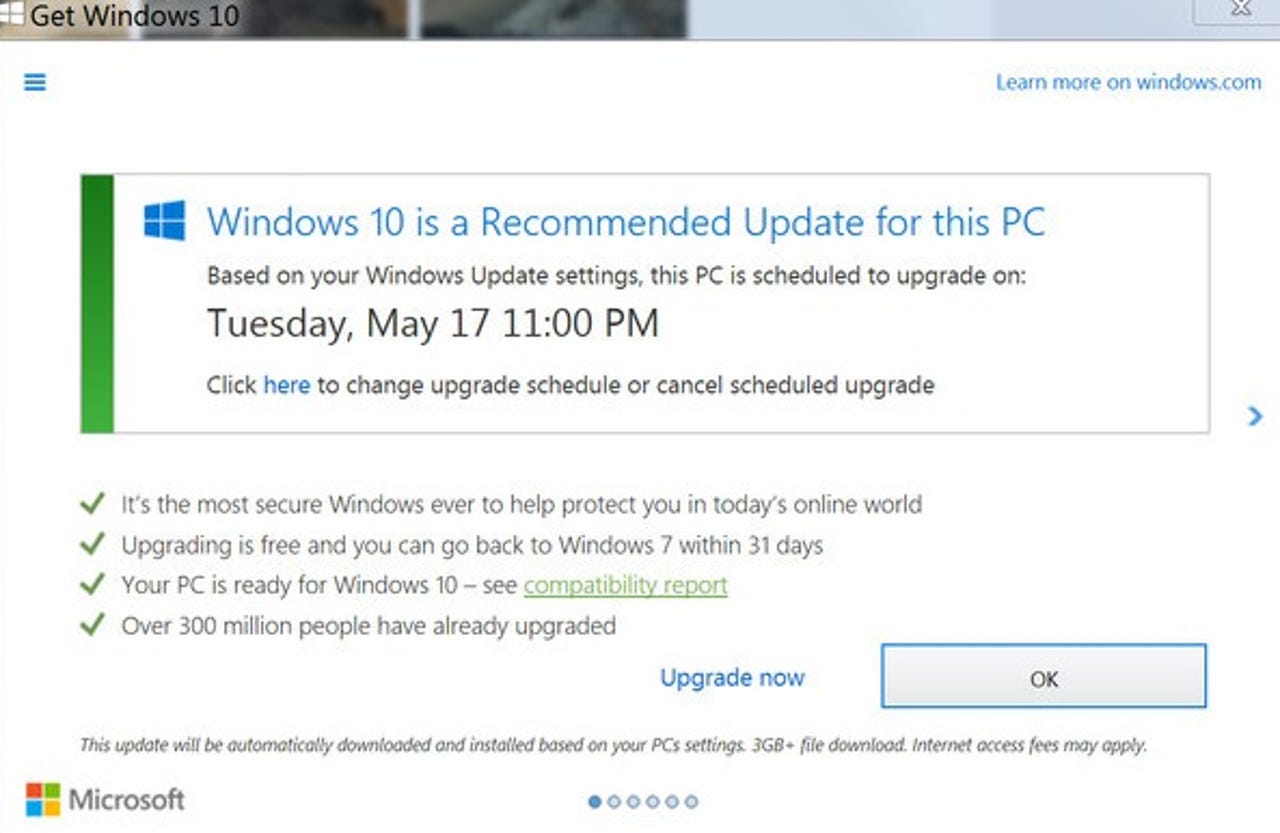Microsoft makes saying no to Windows 10 update a little easier

There have been plenty of complaints -- including from yours truly -- about Microsoft not providing Windows 7 and 8.1 users with enough warnings about Microsoft's Windows 10 update process.

The new 'Get Windows 10' prompt
Happily, it seems Microsoft is giving way a bit with a new, more detailed Get Windows 10 prompt (as seen above, captured by Tom's Hardware).
Even though some Microsoft watchers are portraying Microsoft's latest move as if it were more dastardly than its previous behavior, I actually think the opposite is true.
Microsoft last week changed the way the information provided via its "Get Windows 10" prompt for Windows 7/8.1 users the company has deemed as eligible to get Windows 10 in the form of a "Recommended" update.
The new prompts display a suggested date and time when their PCs will be updated to Windows 10. It also offers users a clearer -- though definitely still not ideal -- way to cancel the update if they don't want it. (That "Click Here" link is still pretty easy to miss.)
The old 'Get Windows 10' prompt
Previously, a number of users didn't realize they could decline the Windows 10 update if they clicked on the X in the upper right corner of the Get Windows 10 prompt box. There wasn't a clearly visible cancel prompt. Users had a choice of getting Windows 10 now or later, as this screen shot above, from earlier this year, indicates.
The interim 'Get Windows 10' prompt
As of last week, Microsoft added more options to the dialog box. It's worth noting this isn't the first time all users received the new prompt. At least some subset of users did see a more detailed Windows 10 update prompt with date/time/cancel options earlier this year (as this screen grab above, from one of my readers from early March indicates).
But as of last week, the more detailed update prompt seems to be the norm, rather than something that only some potential Windows 10 updaters would receive.
I asked Microsoft about the new prompt and a spokesperson confirmed the wording changes to the Get Windows 10 dialog were made on May 12.
"Based on customer feedback, in the most recent version of the Get Windows 10(GWX) app, we confirm the time of your scheduled upgrade and provide you an additional opportunity for cancelling or rescheduling the upgrade," said Microsoft in a Knowledge Base article that covered the changes.
Update (May 24): Sadly, it seems that when adding an explicit option to select cancel with its new Get Windows 10 prompt, Microsoft also changed the behavior of clicking the X in the corner. Instead of cancelling the Windows 10 update, as previously, the action of clicking the X now simply postpones the update. So that's one more thing users who don't want the update need to take into account. Sigh.
The spokesperson reiterated Microsoft's existing policy regarding pushing Windows 10 as a Recommended update:
"With the free Windows 10 upgrade offer ending on July 29th, we want to help people upgrade to the best version of Windows. As we shared in October, Windows 10 will be offered as a 'Recommended' update for Windows 7 & 8.1 customers whose Windows Update settings are configured to accept 'Recommended' updates. Customers can choose to accept or decline the Windows 10 upgrade.
I'm still not a fan of Microsoft's decision to make Windows 10 a Recommended update, as I feel users shouldn't be tricked or pushed to move to a new PC OS release if they don't want or need it. I also am curious if Microsoft will no longer mark Windows 10 as a Recommended update as of July 29 -- the date its free update offer ends. Microsoft officials have said they plan to begin the process or removing the "Get Windows 10" starting on July 29, but still won't comment as to whether the company also will cease designating Windows 10 as a Recommended update on that date, as well.